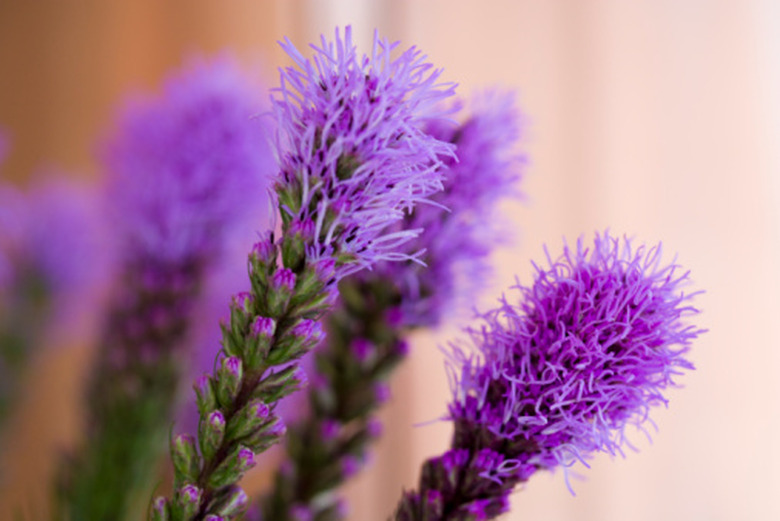Facts About The Blazing Star Plant
Blazing star plants (Liatris spp.) brighten midsummer gardens with their unmistakable spikes of electric pinkish-purple, tufted blooms. These tough, Aster family perennials handle torrid summer heat and humidity as easily as they do winter temperatures approaching minus 40 degrees in U.S. Department of Agriculture Plant Hardiness Zone 3. Their performance as cut or dried flowers equals their usefulness as ornamentals. Gardeners can choose from among several blazing star species and cultivars.
Eastern Species
Liatris spicata, also known as gayfeather, ranks as the most widely commercialized of native blazing star species. L. spicata thrives along marsh edges and in moist meadows across the Eastern United States, where it typically grows 2 to 4 feet high and from 9 to 18 inches wide. Its stem of purple flowers rises from a basal clump of narrow, grasslike green leaves. The blooms open in descending order. Other eastern native blazing star species include rough blazing star (L. aspera), a 1- to 4-foot, August-to-October bloomer. Its button flowers open almost simultaneously, producing a more impressive — but shorter-lived– display than those of L. spicata. Flowering stems can be as long as 32 inches.
- Blazing star plants (Liatris spp.)
- Other eastern native blazing star species include rough blazing star (L. aspera), a 1- to 4-foot, August-to-October bloomer.
Western Species
Rocky Mountain blazing star (L. ligustylis) grows from Montana south to New Mexico and into the Dakotas, Minnesota and Wisconsin. This 1- to 3-foot tall plant can spread anywhere from 6 inches to 2 feet wide. Its 1 1/4-inch flowers bloom simultaneously from midsummer to early autumn. The blossoms' long stalks give plants an open, airy appearance. Compact Liatris punctata forms spreading, clumps 1 to 2 feet high. Its flowers open in a tight, rounded spikes from late summer into midfall. This liatris grows wild from Montana to New Mexico, east through the upper and central Midwest and in Texas. Speckled foliage accounts its common name of dotted blazing star.
- Rocky Mountain blazing star (L. ligustylis) grows from Montana south to New Mexico and into the Dakotas, Minnesota and Wisconsin.
- Its 1 1/4-inch flowers bloom simultaneously from midsummer to early autumn.
Cultivars
Liatris spicata "Kobold" grows between 18 and 30 inches high, with up to 10-inch leaves and summer flowers. The 3/4-inch blooms open on 6- to 15-inch, upright stems. While all blazing star plants attract butterflies, the Liatris ligustylis "Monarch" cultivar has special appeal for Monarch butterflies. Typically reaching 2 feet tall, Monarch shares the species plant's large, long-stalked flowers and late summer blooming season.
Growing Conditions
Different blazing star species have adapted to growing conditions in different parts of the United States. While all of them love full sun, L. spicata does best in moist, fertile well-drained soil during the summer, but suffers in wet winter conditions. Good drainage is especially important for this blazingstar; plants in heavy soils take much longer to establish. Rough blazing star (L. aspera), native to dry prairies and open woodlands, thrives in poor, rocky or sandy soils and handles drought without flinching. Rocky Mountain blazing star (L. ligustylis) prefers dry, poor soils but tolerates moist loam. Plants infertile soil may become tall enough to need staking. A long taproot makes dotted blazing star (L. punctata) the most drought-tolerant of all Liatris plants. It flourishes in well-drained, sandy soil.
- Liatris spicata "Kobold" grows between 18 and 30 inches high, with up to 10-inch leaves and summer flowers.
- Rough blazing star (L. aspera), native to dry prairies and open woodlands, thrives in poor, rocky or sandy soils and handles drought without flinching.
